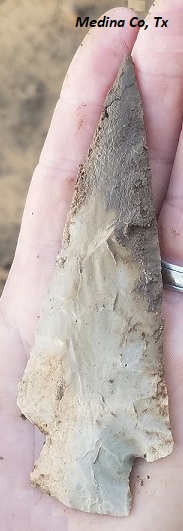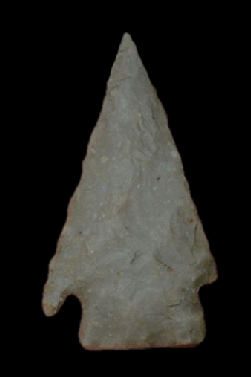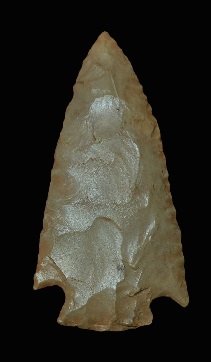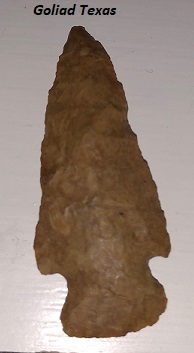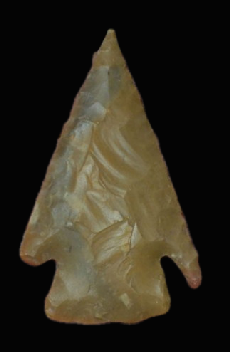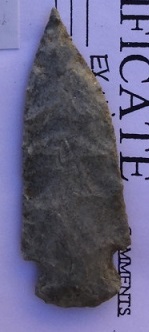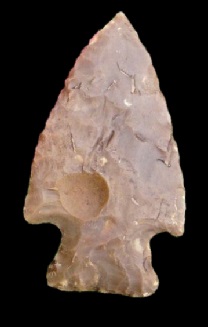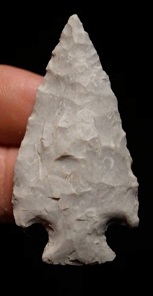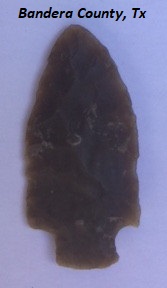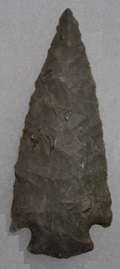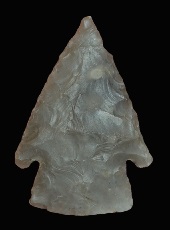Other Websites with Detailed Information:
Name Details:
Named By: Dee Ann Suhm, Alex D. Krieger, Edward B. Jelks
Named For:
Date Identified: 1954
Type Site:
Williams
Cluster:
Commonly Utilized Material:
High quality materials are rarely heat treated while lower
grade cherts are heart treated
Date:
Cultural Period:
4,000 - 2,000 B.P.
Middle to Late Archaic
Neoglacial
Glacial Period:
Culture:
Outline is Representative of Size and Shape:
Description of Physical Characteristics and Flaking Pattern:
This is a broad medium to large triangular corner notch
point with an elliptical cross section. The blade is primarily excurvate. Some examples may have a excurvate tip with the
side becoming almost parallel forming a needle like tip. Heavily re-sharpened examples may have a recurvate shape, flaring out at the shoulder edge. The shoulders are barbed and may range from a slight barb to having the barb extend down to the base of the point. The stem is expanding with a convex base. This point is usually well made and has a random flaking pattern.
Size Measurements: Total Length - 44 to 80 mm
(average 58 to 65 mm),
Stem Length - 12 to 20 mm (typically 1/6 to 1/4 of the total length, 15
mm).
Width at shoulders - 25 to 50 mm (35 to 40 mm average), Neck Width - 10
to 21 mm, Stem Width - 10 to 25
mm, Thickness - 7 to 9 mm (Suhm and Krieger, 1954, Ray et al.,
2009).
Distribution:
Distribution Comments:
This point is primarily found in the Edwards
Plateau and into central to southern Texas.
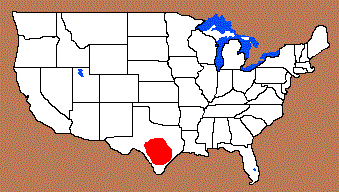
Related / Associated Points:
Additional Comments:
There are many similarities between the Williams
point and the Castroville, Marcos, and Marshall points. The Marcos
point has a notch that enters from the base at a greater angle than the
Castroville point. The Marshall point is generally narrower and has a
distinctly narrower stem than the Castroville. The Williams point has
barbs that do not extend to the base. Re-sharpened examples may take
on the characteristics of a Williams point. There are many overlapping
characteristics with the Lange point.
Other points in this Cluster:
Point Validity: Valid Type
Suhm was an eminent Texas
anthropologist who, among many distinguished positions, served as Director of Texas Archeological Research Laboratory. Krieger was a renowned anthropologist who spent most
of his career in Texas cataloging projectile points and pottery in Texas before moving on to the University of Washington. Jelks was a distinguished anthropologist and
helped organize the newly formed Department of Anthropology at Illinois State University where he was a professor. His work in Texas furthered the understanding of Texas
archeology and was a founding force for the Society of Historical Archeology. This type was named in a professional publication and subsequent book and has many
professional references. This is a valid type.
.
Age Details:
Big Eddy site had multiple radiocarbon dates
ranging from 4040 ± 100 rcybp, 4020 ± 80 rcybp, and 3905 ± 40 rcybp .
Ray et al. (2009) suggests a date of approximately 4200–3500 rcybp
(2200–1500 b.c.)
References: (See Reference Page, Entry Number):
8, 23, 30, 44, 115, 178
Williams Projectile Point, Williams Arrowhead
